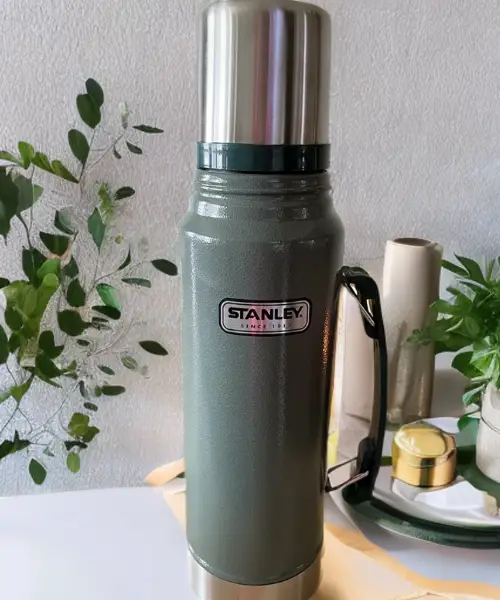Insulated bottles have become a staple in the daily lives of many, from office workers looking to keep their coffee hot throughout the day to adventurers in need of a cold drink during outdoor activities.
Stanley, a well-known brand in the drink container market, offers a range of insulated bottles that promise leak-proof performance and excellent temperature control.
However, some users have encountered an issue where their Stanley thermos appears to be “sweating.”
If you’ve noticed your thermos collecting condensation, it’s crucial to understand the why and how you can fix it to ensure your hot drink stays hot, and your cold drink stays cold.
In this article, we’ll look into the reasons behind a “sweating” Stanley thermos and provide actionable fixes to help you maintain the integrity of your insulated bottle.

How Do Insulated Bottles Work?
Insulated bottles are designed to keep the contents at a stable temperature for extended periods, whether it’s keeping a hot drink warm or a cold drink cool.
They typically feature a double-walled construction with a vacuum seal between the walls. This vacuum space acts as an insulator, preventing heat transfer by conduction or convection.
The result is a highly efficient temperature control system that’s ideal for various uses, from daily commutes to outdoor activities.
The Role of Leak-Proof Design
A key feature of a high-quality insulated bottle is its leak-proof design.
A well-sealed lid ensures that no liquid can escape, and equally important, it prevents outside air and moisture from entering.
This seal is crucial for maintaining the vacuum insulation’s effectiveness and preventing the unwanted “sweating” phenomenon.
Why Is My Stanley Thermos Sweating?
Now, let’s tackle the main question: why is your Stanley thermos sweating? Here are some possible explanations:
Temperature Fluctuations
If you’re using your Stanley thermos in an environment where temperatures fluctuate significantly, you might notice condensation forming on the outside.
This can occur when warm, moist air comes into contact with the colder surface of the bottle, causing water vapor to condense into droplets.
Compromised Insulation
Over time, the vacuum seal of an insulated bottle can become compromised. This could be due to damage from drops or impacts, manufacturing defects, or normal wear and tear.
When the vacuum seal is compromised, the insulation’s effectiveness decreases, and condensation can form as the temperature differential between the inside and outside of the bottle is no longer maintained.
Lid Issues
The lid of your Stanley thermos plays a crucial role in maintaining the vacuum seal. If the lid is not screwed on correctly or if the seal is damaged or worn out, air and moisture can seep in, leading to condensation.
Fixes for a Sweating Stanley Thermos
If you’ve identified that your Stanley thermos is indeed sweating, here are some fixes to help you address the issue:
Proper Use and Maintenance
Ensuring that you’re using and maintaining your Stanley thermos correctly can go a long way in preventing sweating.
Always screw the lid on tightly and inspect the seals regularly for signs of wear or damage. Clean your thermos according to the manufacturer’s instructions, and avoid using abrasive materials that could damage the vacuum seal.
Store at a Consistent Temperature
Try to keep your Stanley thermos in an environment with a relatively stable temperature. Sudden temperature changes can lead to condensation, so storing your bottle in a consistent climate can help minimize sweating.
Check for Damage
Inspect your thermos for any signs of damage, particularly around the lid and the vacuum seal. If you notice any dents or cracks, it might be time to replace your bottle or contact Stanley for a warranty claim if applicable.
Use a Protective Sleeve
Consider using a protective sleeve or carrier for your Stanley thermos.
Not only will this provide an extra layer of insulation, but it can also absorb any condensation that does form, keeping the exterior of the bottle dry.
Preventing Future Issues
To ensure the longevity of your Stanley thermos and prevent future sweating issues, here are some additional tips:
Regular Inspections
Make it a habit to regularly inspect your thermos for any signs of wear or damage. Pay special attention to the lid and the area around the vacuum seal.
Catching issues early can prevent more significant problems down the line.
Invest in Quality
Choosing a high-quality insulated bottle from the outset can save you from headaches in the future.
Stanley has a reputation for quality, but make sure to select a model that fits your specific needs and has positive reviews regarding its leak-proof and insulation performance.
Understand the Limits
Every insulated bottle has its limits when it comes to temperature control.
Familiarize yourself with the specifications of your Stanley thermos, including how long it can keep drinks hot or cold, and use it accordingly to prevent pushing it beyond its capabilities.
Conclusion
A “sweating” Stanley thermos can be frustrating, especially when you’re relying on it to keep your drinks at the perfect temperature during work or outdoor activities.
By understanding the causes and implementing the fixes outlined in this article, you can ensure that your insulated bottle performs at its best.
Remember, proper maintenance and care are key to the longevity of your Stanley thermos. With the right practices, you can enjoy leak-proof, temperature-controlled convenience for years to come.
